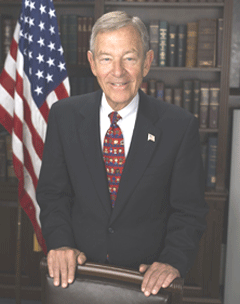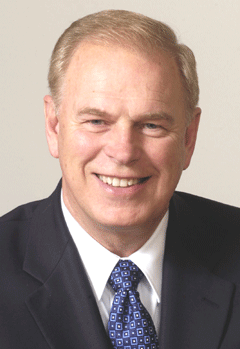Green Jobs For Blue Collar Votes
Air Date: Week of February 29, 2008

Clean energy for Cleveland? Both Democratic candidates used the recent debate in Ohio to say green jobs can ease Ohio’s blue-collar blues. (Photo: Cleveland State University)
The leading candidates for president are all counting on clean energy to create new jobs. But will those political promises come to pass? Living on Earth's Jeff Young says the election year battleground state of Ohio could offer some answers.
Transcript
[THEME]
CURWOOD: From the Jennifer and Ted Stanley studios in Somerville, Massachusetts, this is Living on Earth. I’m Steve Curwood. For years we’ve heard politicians talk about the economy versus the environment: If you want cleaner air and water, it’s going to cost you – lost jobs, higher prices.
But in the presidential campaign of 2008 that paradigm has shifted. Now all the major candidates talk about the environment helping the economy.
CLINTON: The clean energy agenda is a jobs agenda.
MCCAIN: We will stimulate green technologies. This will be profit-making business.
OBAMA: Reducing energy consumption isn’t a drag on our economy, it is the future of our economy.
CURWOOD: Senators Clinton, McCain and Obama all see green-collar jobs in the future – jobs generated by a massive shift in the energy industry. But how realistic are these electioneering promises. Living on Earth’s Jeff Young has been finding some answers.
MACEWAN: I invite you to join me in a sunny, Solar Integrated welcome for Governor Arnold Schwarzenegger, the people’s governor.
[APPLAUSE]
YOUNG: When California’s Arnold Schwarzenegger endorsed Senator John McCain for president, he made the announcement in a solar power equipment company in Los Angeles.
SCHWARZENEGGER: This is a perfect place to talk about our shared commitment to protecting the environment and to stimulate the economy at the same time.
YOUNG: Schwarzenegger and McCain are probably the most prominent Republicans to embrace reductions in greenhouse gases as a positive step for the economy.
MCCAIN: With the development of green technologies, we can have reduced costs to the American consumer.
YOUNG: And California is proof. Solar companies alone produced thousands of new jobs there thanks to aggressive state policy, innovative local organizers and abundant venture capital. Well that’s great for sunny California, but you rarely hear people talk about sunny Toledo or Akron. Yet Mid-western, rust belt Ohio is where the presidential candidates are really pushing green jobs. It’s a crucial battleground state where the issue is jobs – capital “J”. Listen to Senators Barack Obama and Hillary Clinton at the recent MSNBC debate in Cleveland.

Clean energy for Cleveland? Both Democratic candidates used the recent debate in Ohio to say green jobs can ease Ohio’s blue-collar blues. (Photo: Cleveland State University)
OBAMA: The potential for creating green jobs that can not just save on our energy costs but, more importantly, can create jobs in building windmills, that will produce manufacturing jobs here in Ohio.
CLINTON: I want to see people throughout Ohio being trained to do the work that will put solar panels on roofs, install wind turbines, do geothermal, take advantage of biofuels – these are jobs that have to be done in Youngstown, in Dayton, in Cincinnati.
YOUNG: Both Democrats propose multi-billion dollar investments in clean-energy technology and job training. McCain’s proposal is less detailed but he also sees robust job growth. And Ohio could sure use some- it’s lost tens of thousands of manufacturing jobs. But some argue that the candidates’ proposals could make things worse. Ken Green is a resident scholar at the American Enterprise Institute, a free-market-oriented think-tank. Despite his name, Green does not buy the green jobs agenda.
GREEN: But in reality these are not new jobs. What happens is government is going to be breaking jobs in a different energy sector, and they’re going to be giving some of those jobs over to the renewable sector. But because the renewables are not competitive economically, there will be less jobs on net rather than more.

Ohio Sen. George Voinovich-R warns that shifting the economy to address climate change could hit Ohio hard: “What am I supposed to say to the families on the wrong end of the shift?”
(Courtesy of U.S. Senate)
VOINOVICH: Significantly decreasing household income while significantly increasing energy prices and driving businesses overseas. What am I supposed to say to the men and women, families and communities who find themselves on the wrong end of the shift?
YOUNG: But Ohio’s current governor dismisses such talk. Democrat Ted Strickland wants a clean energy standard for Ohio, with a quarter of its energy coming from either renewables like wind or solar, or “advanced” technologies like coal that captures carbon emissions.
STRICKLAND: If you just knew the companies that contact my office, many of them from other countries, who are interested in reducing renewable sources of energy in Ohio, this is a way to create thousands of high paying manufacturing jobs in Ohio. And for those who imply that green technology somehow will cost us jobs, well it’s quite the opposite.

Ohio Gov. Ted Strickland-D is pushing his state to produce more renewable energy and put Buckeyes back to work on wind and solar equipment. (Courtesy of Ohio Office of the Governor)
BEZDEK: What Ohio can gain, to stop or at least alleviate the hemorrhaging of manufacturing jobs that has occurred over the past decade – I’m not saying this is the entire answer to all these states manufacturing woes, but it can be a major part of the solution.
YOUNG: Bezdek found Ohio could gain two point two million jobs in renewable energy and the larger business of energy efficiency over the next 25 years. “Could” is the operative word here. And Bezdek is quick to point out that those figures assume a very aggressive government approach to incentives and investments. And he warns there is already stiff competition. European wind giant Vestas was considering a new facility in Ohio, but chose wind-friendly Colorado instead.
BEZDEK: You just can’t go into a place like Ohio and say ‘well, we’re gonna wave a magic wand and next year we’re going to have 500,000 green-collar jobs in manufacturing. It simply doesn’t recognize the fact that Ohio’s already behind the curve in many of these areas.
YOUNG: What should Ohioans make of the message they’re hearing from candidates. Is this a good economic medicine that they’re peddling here?
BEDZEK: I mean I guess the good news is that renewable energy, energy efficiency, green collar jobs is a new motherhood and apple-pie type of thing that everyone’s in favor of it. And promises are cheap, and it’s not going to be cheap, it’s not going to be easy, and it’s not going to be quick.”
YOUNG: For all of Bezdek’s caveats and cautions, his study’s numbers are eye-popping. Even moderate government support could yield four million jobs nationwide just in renewable energy. And if the U.S. really went all out for clean energy and efficiency, the payoff could be 40 million jobs by the year 2030. Nearly one in five American paychecks would be some shade of green. For Living on Earth, I’m Jeff Young in Washington.
Links
Read Roger Bezdek’s green jobs study, commissioned by the American Solar Energy Society
Living on Earth wants to hear from you!
Living on Earth
62 Calef Highway, Suite 212
Lee, NH 03861
Telephone: 617-287-4121
E-mail: comments@loe.org
Newsletter [Click here]
Donate to Living on Earth!
Living on Earth is an independent media program and relies entirely on contributions from listeners and institutions supporting public service. Please donate now to preserve an independent environmental voice.
NewsletterLiving on Earth offers a weekly delivery of the show's rundown to your mailbox. Sign up for our newsletter today!
 Sailors For The Sea: Be the change you want to sea.
Sailors For The Sea: Be the change you want to sea.
 The Grantham Foundation for the Protection of the Environment: Committed to protecting and improving the health of the global environment.
The Grantham Foundation for the Protection of the Environment: Committed to protecting and improving the health of the global environment.
 Contribute to Living on Earth and receive, as our gift to you, an archival print of one of Mark Seth Lender's extraordinary wildlife photographs. Follow the link to see Mark's current collection of photographs.
Contribute to Living on Earth and receive, as our gift to you, an archival print of one of Mark Seth Lender's extraordinary wildlife photographs. Follow the link to see Mark's current collection of photographs.
 Buy a signed copy of Mark Seth Lender's book Smeagull the Seagull & support Living on Earth
Buy a signed copy of Mark Seth Lender's book Smeagull the Seagull & support Living on Earth

